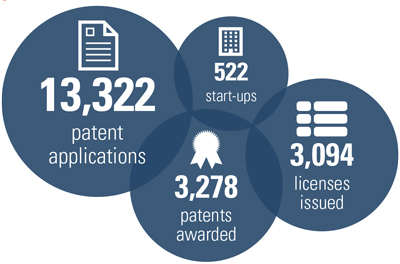Section 2: Public Research Universities Contribute to the Innovation Economy
As research and education centers, public research universities fuel state and
national economic development. For example, in 2012–2013, the
University of North Carolina system and its affiliated medical institutions added
$27.9 billion in income to the state economy.13
Between 2012 and 2013, research at public universities resulted in more than14 |

|
Universities foster research- and innovation-based relationships with business, industry, the nonprofit sector, and government. The University of Cincinnati Research Institute, VT KnowledgeWorks at Virginia Tech, and Innovate ABQ at the University of New Mexico all connect academic experts to industry partners and serve as hubs of innovation and engines of growth. Many universities have created innovation accelerators that encourage a culture of entrepreneurship by sponsoring start-up competitions, providing seed funding, or offering catalyst grants, while also serving as magnets to business and industry. The top innovation clusters in the country are affiliated with and geographically near research universities, both public and private.
Universities manage their intellectual property for the public good. While technology transfer and intellectual property can result in new revenue for public research universities, the primary purpose of these policies is to serve the public interest. Universities stimulate economic growth through responsible management of intellectual property and its transfer.
ENDNOTES
13 University of North Carolina, North Carolina Independent Colleges & Universities, and North Carolina Community Colleges, Demonstrating the Collective Economic Value of North Carolina’s Higher Education Institutions (February 2015), 2, http://www.northcarolina.edu/sites/default/files/documents/nche_mainreport_final_feb17.pdf.
14 Association of University Technology Managers, AUTM Licensing Activity Survey FY2013 (Deerfield, Ill.: Association of University Technology Managers, 2014).
15 The Economic Research Organization at the University of Hawai’i, The Economic Impact of the University of Hawai’i System (Honolulu: University of Hawai’i Economic Research Organization, 2013), http://www.uhero.hawaii.edu/assets/UHSystemImpactReport-Public.pdf.
16 Alan W. Hodges, Thomas J. Stevens, Rodney L. Clouser, Julie Harrington, Martijn Niekus, and Keith Baker, Economic Contributions of the State University System of Florida in Fiscal Year 2009–10 (March 8, 2012), http://www.fred.ifas.ufl.edu/economic-impact-analysis/pdf/SUS-of-Florida-FY-2009-10.pdf.
17 PitchBook, “The Top 50 Universities Producing VC-Backed Entrepreneurs,” PitchBook Venture Capital Monthly, August/September 2014, 5.
